
a web page by Don Roberson |
PARROTBILLS & ALLIES Paradoxornithidae |
||||||||
|
||||||||
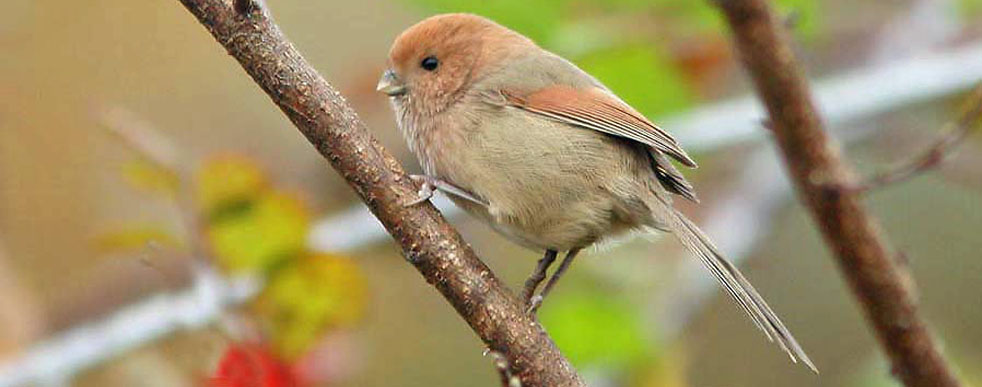 |
||||||||
 The Parrotbills have long been one of the traditional bird families [Robson 2007, Sibley & Monroe 1990]. They range from tiny birds that travel in flitty packs through bamboo thickets to large big-billed species, and as a group are rather little-known. Two of the small ones are Vinous-throated Parrotbill (above) and Spectacled Parrotbill (left). Vinous-throated is widespread in eastern Asia, moving quickly in flocks, often in riverine scrub. Spectacled is restricted to montane bamboo patches in central China. Note how the bill of each species is compressed to deal with bamboo. The Parrotbills have long been one of the traditional bird families [Robson 2007, Sibley & Monroe 1990]. They range from tiny birds that travel in flitty packs through bamboo thickets to large big-billed species, and as a group are rather little-known. Two of the small ones are Vinous-throated Parrotbill (above) and Spectacled Parrotbill (left). Vinous-throated is widespread in eastern Asia, moving quickly in flocks, often in riverine scrub. Spectacled is restricted to montane bamboo patches in central China. Note how the bill of each species is compressed to deal with bamboo.
Some of the earlier molecular studies — Cibois (2003), Jønsson & Fjeldså (2006), Gelang et al. (2009), Cibois et al. (2010), Fregin et al. (2012), Moyle et al. (2012) — had merged the parrotbills into one or another part of a broader "babbler" assemblage. The closest relatives are the sylvid "warblers." — that is what is left of the family Sylviidae after the break-up of the Old World warblers in the early 2000s — and some authorities put parrotbills into Sylviidae. Yet, the evidence presented by these publication (e.g., Fregin et al. 2012), Moyle et al. 2012) showed that there were two distinct lineages (clades) within this "new" Sylviidae. One clade was the genus Sylvia [33 "warblers" and several related African genera], and in the other clade were parrotbills and their allies.
|
||||||||
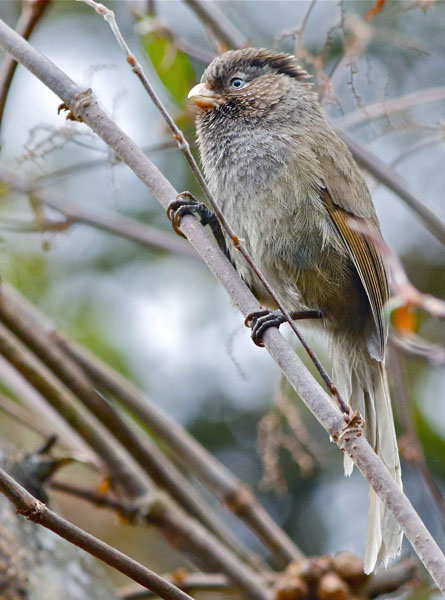 Fortunately, Cai et al. (2019) — whose authors include 8 co-authors from the previous set of publications — acknowledged that Parrotbills deserve to have their own family: "According to our results," wrote those authors in 2019, "the Sylviidae ... are divided into two large clades (A and B) that diverged in the early Miocene (19.5 mya), similar in time to the other families of babblers. We therefore suggest the name Sylviidae be restricted to the western clade ... whereas we propose to reinstall the family group name Paradoxornithidae for the eastern clade;" [emphasis added]. Fortunately, Cai et al. (2019) — whose authors include 8 co-authors from the previous set of publications — acknowledged that Parrotbills deserve to have their own family: "According to our results," wrote those authors in 2019, "the Sylviidae ... are divided into two large clades (A and B) that diverged in the early Miocene (19.5 mya), similar in time to the other families of babblers. We therefore suggest the name Sylviidae be restricted to the western clade ... whereas we propose to reinstall the family group name Paradoxornithidae for the eastern clade;" [emphasis added].This is great news! Each of the two clades are distinctive, recognizable, and of ancient origin. Bill shape, and its bamboo-loving habits, easily identified the rather large Brown Parrotbill (right) as a Paradoxornithid. It is a bird of bamboo in evergreen forests from 1900-3600m (6200-11000' elev) in the Himalayas and China. Moyle et al. (2012) had previously recognized the white-eyes as a family [Zosteropidae], and they diverged from the core babblers in the early Miocene about 16-21 million years ago (mya). Moyle et al. (2012) proposed that younger divergences — such as three clades in the core babblers that diverged about 11-18 mya — are better classified as subfamilies. Confirming this estimate, Voelker & Light (2011) explicitly found that the two sylvid clades diverged about 20 mya [19.4 mya was estimated for the age of extant lineages]. Thus, applying the same standards to similar situation, it is — and long has been — appropriate to maintain that the "new Sylviidae" is actually two families: the sylvid warblers [Sylviidae] and the parrotbills and allies [Paradoxornithidae]. Thus the "traditional" and distinctive Parrotbill family is conserved. Not all global family lists have yet adopted this proper course; perhaps the Covid-19 pandemic has delayed ornithologists. But I, for one, heartily re-welcome the return of the Paradoxornithidae! [In an oddity, at one time Bearded Reedling Panurus biamicus was thought to be a parrotbill. As the oldest named taxa among the traditional group, Parrotbills were traditionally called the "Panuridae." As it turns out, the Reedling is not related to parrotbills at all (Cibois 2003). It is a very early offshoot at the base of the sylvoid assemblage and is now placed in its own family]. |
||||||||
The molecular evidence has added new elements to the traditional Parrotbills [Cibois (2003), Gelang et al. (2009), Moyle et al. (2012)]. While the family has lost Bearded Reedling, it has added five babblers — Yellow-eyed and Jerdon's Babblers (genus Chrysomma), Rufous-tailed Babbler (genus Moupinia), and two Chinese babblers (genus Rhopophilus) — plus 8 species of Fulvetta fulvettas; one Lioparus fulvetta (Golden-breasted Fulvetta); and Fire-tailed Myzornis (genus Myzornis). And, in the New World, there is the Wrentit (more below on that). The latter two Old World species are drop-dead gorgeous gems in the Himalayas. Fire-tailed Myzornis (below left) simply glows in mixed species flocks at subtropical elevations in the eastern Himalayas. The tiny and distinctive Golden-breasted Fulvetta (below right) travels in small flocks that very nervously work through bamboo, constantly moving, and are hard to photograph. Its range extends beyond to Himalayas into mountainous central China. |
||||||||
|
||||||||
The core of the Paradoxornithidae is the 22 parrotbills, now assigned to 8 genera in one recent compilation (Cai et al. 2019). The second largest set are the fulvettas: one species in genus Lioparus (Golden-breasted, shown above right) and 8 species in the genus Fulvetta. Before the latest molecular studies, that genus was submerged in genus Alcippe (which is now proposed as its own family). Now that genus Fulvetta is carved out again, and transferred to the Paradoxornithidae, we can say that the Fulvetta fulvettas are a group of small, active birds — either brown and rusty or gray and rusty, and usually with complex facial patterns — that occur primarily in the Himalayas or in China (with one on Taiwan). This is similar distribution to that of the actual parrotbills. Most of them join mixed species flocks in subtropical forests: a good example is White-browed Fulvetta (below left). It is common in most of the Himalayas, and has elevational migrations, moving downslope in winter. The center of parrotbill distribution is in China, Tibet, and the northern parts of southeast Asia (especially northern Burma and Laos). The largest one, and the biggest bill, is on the monotypic Great Parrotbill Conostoma oernodium, which lives in bamboo forests of Nepal, Tibet and China. White-breasted Parrotbill (below right) is a mid-sized parrotbill that used to be known as "Greater Rufous-headed Parrotbill" (e.g., Inskipp et al. 1999). White-breasted Parrotbills forage rapidly in pairs or small parties of 6-8, often hanging upside down. They feed on insects, seeds, and berries, and can easily bite through bamboo shoots with sharp-edged bills. This is one species that heavily relies on bamboo. It was recently split from Rufous-headed Parrotbill Psittiparus bakeri, of mountains in Assam, India; in northern Myanmar; and in the Tonkin Mts. of Laos. A smaller species, now called Pale-billed Parrotbill Chleuasicus atrosuperciliaris, used to be named "Lesser Rufous-headed Parrotbill, but it has since been placed in its own monotypic genus. Pale-billed Parrotbill often forages with the larger White-breasted or Rufous-headed Parrotbills, as its range overlaps that of both larger species. |
||||||||
|
||||||||
At various times Wrentit has been considered most closely related to bushtits, to titmice, to babblers, to Old World warblers, or to wrens; it has at various times been elevated to its own family ["Chamaeidae"]. Sibley & Ahlquist (1982) used DNA-DNA hybridization technique to compare it with various babblers and Old World warblers plus a titmouse, a gnatcatcher, a kinglet, and more distantly related birds. The results showed that the Wrentit was closest to certain babblers and to "warblers" in the genus Sylvia. Molecular work (Burns & Barhoum 2006) showed that Wrentit became isolated in the dense California chaparral during the Pleistocene. Its ancestors presumably arrived in North America across the Bering Straits land-bridge. It diverged from its ancestors between 6.5 and 8.1 million years ago. During the cooler centuries of the Pleistocene, over 200,000 years ago, its range was probably restricted to southern California and Baja. With the retreat of the ice age, its range expanded north through the foothill chaparral on both sides of California's Central Valley, eventually reaching southern Oregon. Initially genetic studies of the Wrentit (Cibois 2003, Burns & Barhoum 2006) suggested that its closest relatives were parrotbills in the genera Alcippe, Chrysomma, and/or Paradoxornis, but Moyle et al. (2012) found it closer to the parrotbills in Conostoma. |
||||||||
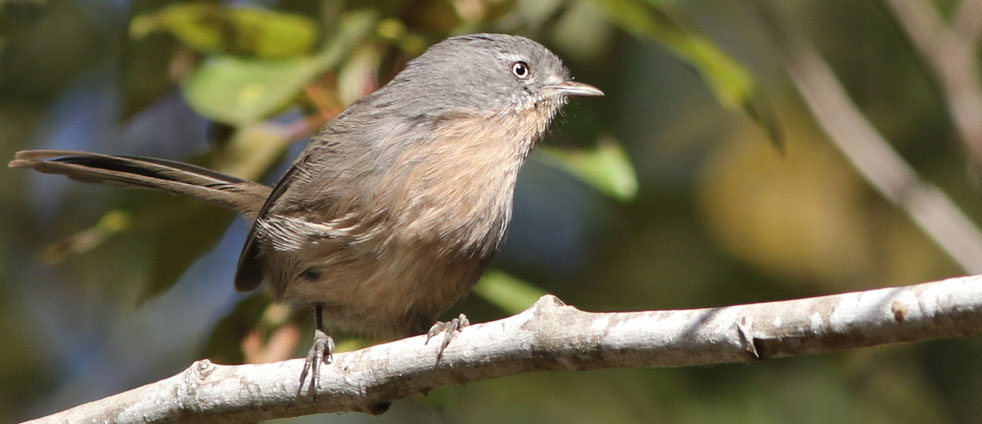 |
||||||||
Photos: The Vinous-throated Parrotbill Sinosuthora webbianus was in Foping Nature Reserve, Shaanxii, China, in Nov 2010. The Spectacled Parrotbill Sinosuthora conspicillatus was at Huayang Village, Shaanxii, China, on 8 Nov 2010. The Brown Parrotbill Cholornis unicolor was in the botanical gardens at Docuhula, Bhutan, on 1 Apr 2019. The Fire-tailed Myzornis Myzornis pyrrhoura was in the Korela Forest, Bhutan, on 20 Mar 2019. The Golden-breasted Fulvetta Lioparus chrysotis was along Lingmethang Rd., Bhutan, on 23 Mar 2019. The White-browed Fulvetta Fulvetta vinipectus was along the Trongsa Road, Bhutan, on 26 Mar 2019. The White-breasted Parrotbill Psittiparus ruficeps was along Lingmethang Rd., Bhutan, on 21 Mar 2019. The Black-breasted Parrotbill Paradoxornis flavirostris was in Kaziranga NP, Assam, India, on 1 Apr 2001. The Wrentit Chamaea fasciata carrying food to a fledgling was at Garrapata SP, Monterey Co., California, in 23 May 2010; the fresh-plumaged fall Wrentit was at Andrew Molera SP, California, on 9 Oct 2016. Bibliographic notes: There is no "family book" on the parrotbills but an good introduction to the family, with excellent photos, is in Robson (2007). Literature cited:
|
||||||||
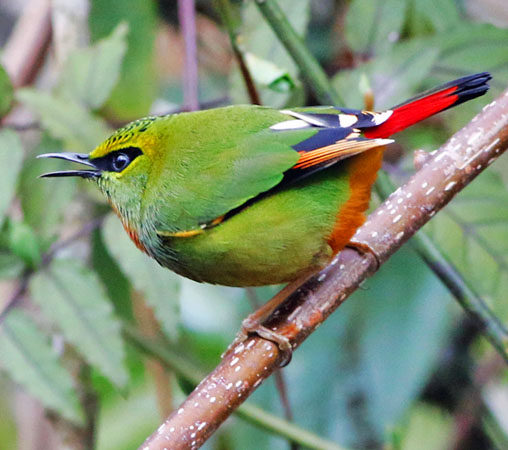
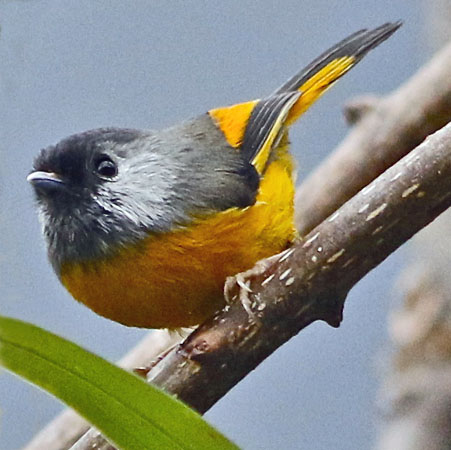

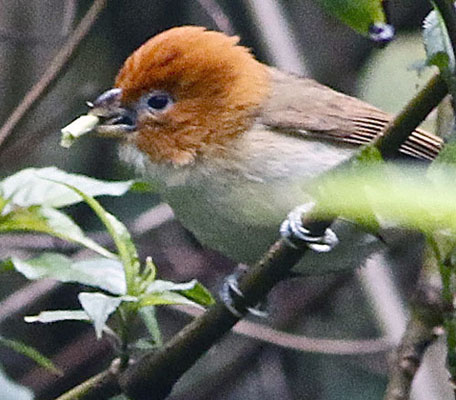

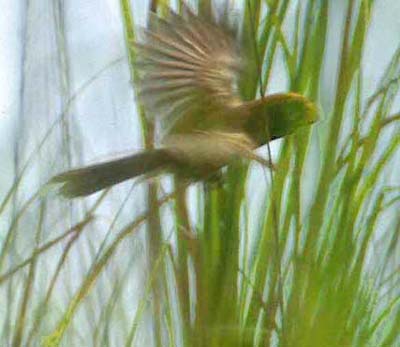
 Finally, there is the Wrentit (right and below) of the New World. It is a shy but vocal little bird in the western United States. Like many Asian parrotbills, pairs apparently mate for life and are entirely resident, spending their entire lives within a few acres of scrub. Their characteristic "bouncing-ball" territorial song is easily imitated and is the soundtrack of California chaparral, but they also give a cat-like purrr and a variety of scolding notes.
Finally, there is the Wrentit (right and below) of the New World. It is a shy but vocal little bird in the western United States. Like many Asian parrotbills, pairs apparently mate for life and are entirely resident, spending their entire lives within a few acres of scrub. Their characteristic "bouncing-ball" territorial song is easily imitated and is the soundtrack of California chaparral, but they also give a cat-like purrr and a variety of scolding notes.